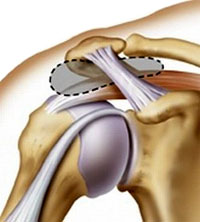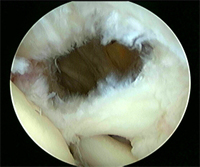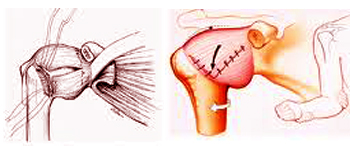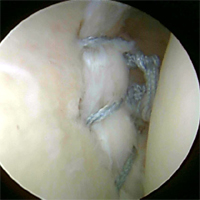Shoulder Surgery
Shoulder is a complex joint which functionally comprises of Glenohumeral joint, Scapulothoracic joint, Acromioclavicular joint and Sternoclavicular joint. The common causes of pain in shoulder joint are:
Impingement Syndrome
Impingement syndrome is pinching of tendons and bursa of rotator cuff between bones. In many individuals as the shape of their bones allows less space than others thus causing small thickenings of tendons/bursa that aggravate the symptoms. Further, there are chances of an initial injury also setting off process of inflammation and thickening of these structures. Taking up more space thickening cause pinching down of tendons and bursa, thus aggravating the situation even more.

Symptoms
Some of the common symptoms include:
- Generation of pain with overhead activities (arm held above head height)
- Pain while sleeping
- Pain over outside of shoulder/upper arm
Diagnosis
Making accurate diagnosis is important for delivering proper treatment. Initially physical examination is required for making the diagnosis of impingement syndrome. Other than these, some other diagnostic processes that are followed include:
- X-rays – To assess bony anatomy of shoulder
- MRI – To ensure there is no sign of rotator cuff tear
Non Invasive Treatment Process
The non invasive treatment process of impingement syndrome begins with some simple steps. These include:
Rest – First step of treatment is decreasing inflammation that is achieved by avoiding problems causing inflammation
Anti-Inflammatory Medication – Anti-inflammatory medication help with getting down the inflammation of tendons and bursa, thus reducing the discomfort
Ice Application – A helpful treatment of inflammation, ice helps in reducing inflammation, relieving pain and stimulating blood flow to injured shoulder area
Shoulder Exercises – Simple exercises as prescribed by the doctor may assist in strengthening the rotator cuff and help shoulder move more efficiently, thus allowing patients to return to normal activities without pain.
Other than these, it is also important to avoid activities which can irritate rotator cuff tendons. These comprise:
- Overhead weight lifting
- All throwing activities
- Sleeping with arm over/behind the head
Cortisone Injection – If symptoms are not completely treated, patients are administered steroid shot into area of inflammation that helps in treating inflammation directly in problem area.
Surgery
Many patients respond to non-surgical treatments. But for some individuals who do not respond to simple treatment, surgery can only be the step that can provide relief to the shoulders. The surgical procedure used by us for treatment is called subacromial decompression and is performed using instruments including video camera and shaver inserted using small incisions that are used for identifying and removing inflamed bursa.
Further, depending on bone above rotator cuff, burr may also be used for removing some bone area so as to create more space for rotator cuff tendons.
Rehabilitation
The process includes:
- Patient’s shoulders getting placed in shoulder slings following surgery for impingement syndrome
- Unlike surgery for rotator cuff tear, there is no requirement for period of restricted motion that allows tendon healing
- In cases of isolated subacromial decompression, patients can immediately begin gentle motion after surgery
- Strengthening can be done within few weeks with active body movements resuming after subsiding of the swelling
Rotator Cuff Tear & Repair
Rotator cuff tears denote common injuries to complicated joint that can result into frustrating experience. As a group of four tendons and muscles surrounding shoulder joint, rotator cuff injury relates to damages to its tendons that connect rotator cuff muscles to bone. In the condition of tendons getting inflamed or torn, they cannot function properly and are a cause of pain in the shoulders.

Symptoms
Pain over the top of shoulder is most common symptom of rotator cuff problem. Other than this, some of the other symptoms include:
- Patients feeling pain descending down the outside of arm all way to elbow
- Weakness of shoulder in carrying out day-today activities

Bankart Leison & Repair
The detachment of fibro-cartilaginous edge of shoulder socket from bony socket is called Bankart lesion. Cases those are associated with Bankart lesion includes:
- Recurrent Shoulder Instability
- Dislocation

The lesion created due to the un-stability of shoulder ligament that are attached to glenoid labrum causes potential pocket for humeral head to displace during dislocation. This mainly occurs when arm is taken into position of abduction & external rotation that causes shoulder instability and require repair of Bankart lesion for restoring the shoulder stability.
Procedure
Generally maximum numbers of cases are successfully treated using this procedure. As per Senior Orthopaedic Surgeon Dr. L. Tomar this procedure is carried out using small incisions around shoulder and requires an overnight Hospital stay only. Some of the steps involved in this procedure include:
- Mobilisation of glenoid labrum and shoulder ligaments
- Preparation of glenoid edge
- Insertion of drill holes to glenoid edge for bone anchor placement
- Passage of sutures through glenohumeral and labrum ligament
- Insertion of anchors into glenoid and repairing glenohumeral and glenoid labrum ligaments to edge of glenoid

